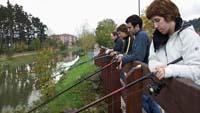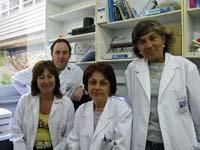Fishes of two sexes in Urdaibai

Look at P. The group of Cell Biology in Environmental Toxicology, led by Professor Cajaraville, concluded that various chemical compounds present in water influence the growth, behavior, reproduction and immune function of organisms by interfering with the endocrine system. Therefore, these endocrine disrupting compounds have been called: alkylphenols (from household detergents and cosmetics), pesticides, plasticizers, petroleum derivatives or synthetic hormones. Sometimes it is the organisms themselves that are affected and sometimes appear in second or third generation.
Bisexual organisms (bisexual organisms)
The extraordinary amount of hermaphroditic mussels and disorders found in the development of their gametes launched the DERBIUR project that will end in December 2008. The aim of this study is to define the existence of possible endocrine disruptors in Urdaibai and to study the possible modifications that these substances can produce in bivalve mollusks (mussels, oysters...) and fish.
On this occasion, significant results have also been obtained. On the one hand, they confirmed alterations in the development of gametes of mussels (female and male cells necessary for sexual reproduction). On the other hand, it has been detected that in the fish that surround the purifier that processes the wastewater of Gernika, specifically in the loops, the prevalence of the intersex is high, since a third of the braces have female gametes.
Biomarkers, a sign of changes
To reach these conclusions, in addition to microscopic studies, researchers from the Faculty of Science and Technology of the UPV/EHU have had several biomarkers. For example, changes in the levels of vitelogenin fish have been observed. The vitelogenin protein is characteristic of females and is used as a biomarker of feminization. In fact, the Cajaraville team realizes that some braces also contain this protein.

Furthermore, thanks to the chemical analyses carried out by the CDI/CSIC of Barcelona, high levels of alkylphenols metabolites have been found in the gallbladder. Therefore, the alkylphenols can be responsible for the changes found in the corks.
The research team has a mobile laboratory that allows to perform dissections of organisms immediately after leaving the water. Some of the samples obtained from these dissections are fichadas in them for later observation through microscopes and the rest is frozen to perform studies of gene expression and proteins in the laboratory of Cell Biology and Histology of the University.
The results obtained by the UPV researchers coincide with the research that is being carried out at the international level. On the other hand, the CID/CSIC of Barcelona has made similar discoveries to those of Urdaibai in the fish of the Ebro River.







